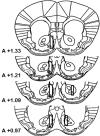N-Methyl-d-aspartate receptor co-agonist availability affects behavioral and neurochemical responses to cocaine: insights into comorbid schizophrenia and substance abuse
- PMID: 29168271
- PMCID: PMC5966316
- DOI: 10.1111/adb.12577
N-Methyl-d-aspartate receptor co-agonist availability affects behavioral and neurochemical responses to cocaine: insights into comorbid schizophrenia and substance abuse
Abstract
Both schizophrenia (SZ) and substance abuse (SA) exhibit significant heritability. Moreover, N-methyl-d-aspartate receptors (NMDARs) have been implicated in the pathophysiology of both SZ and SA. We hypothesize that the high prevalence of comorbid SA in SZ is due to dysfunction of NMDARs caused by shared risk genes. We used transgenic mice with a null mutation of the gene encoding serine racemase (SR), the enzyme that synthesizes the NMDAR co-agonist d-serine and an established risk gene for SZ, to recreate the pathology of SZ. We determined the effect of NMDAR hypofunction resulting from the absence of d-serine on motivated behavior by using intracranial self-stimulation and neurotransmitter release in the nucleus accumbens by using in vivo microdialysis. Compared with wild-type mice, SR-/- mice exhibited similar baseline intracranial self-stimulation thresholds but were less sensitive to the threshold-lowering (rewarding) and the performance-elevating (stimulant) effects of cocaine. While basal dopamine (DA) and glutamate release were elevated in the nucleus accumbens of SR-/- mice, cocaine-induced increases in DA and glutamate release were blunted. γ-Amino-butyric acid efflux was unaffected in the SR-/- mice. Together, these findings suggest that the impaired NMDAR function and a consequent decrease in sensitivity to cocaine effects on behavior are mediated by blunted DA and glutamate responses normally triggered by the drug. Projected to humans, NMDAR hypofunction due to mutations in SR or other genes impacting glutamatergic function in SZ may render abused substances less potent and effective, thus requiring higher doses to achieve a hedonic response, resulting in elevated drug exposure and increased dependence/addiction.
Keywords: N-methyl-d-aspartate receptor; addiction; d-serine; schizophrenia; serine racemase.
© 2017 Society for the Study of Addiction.
Figures





Similar articles
-
The Role of Serine Racemase in the Pathophysiology of Brain Disorders.Adv Pharmacol. 2018;82:35-56. doi: 10.1016/bs.apha.2017.10.002. Epub 2017 Nov 29. Adv Pharmacol. 2018. PMID: 29413527 Free PMC article. Review.
-
Availability of N-Methyl-d-Aspartate Receptor Coagonists Affects Cocaine-Induced Conditioned Place Preference and Locomotor Sensitization: Implications for Comorbid Schizophrenia and Substance Abuse.J Pharmacol Exp Ther. 2015 Jun;353(3):465-70. doi: 10.1124/jpet.115.223099. Epub 2015 Mar 18. J Pharmacol Exp Ther. 2015. PMID: 25788713 Free PMC article.
-
In vivo magnetic resonance studies reveal neuroanatomical and neurochemical abnormalities in the serine racemase knockout mouse model of schizophrenia.Neurobiol Dis. 2015 Jan;73:269-74. doi: 10.1016/j.nbd.2014.10.009. Epub 2014 Oct 23. Neurobiol Dis. 2015. PMID: 25461193 Free PMC article.
-
An mGlu5-Positive Allosteric Modulator Rescues the Neuroplasticity Deficits in a Genetic Model of NMDA Receptor Hypofunction in Schizophrenia.Neuropsychopharmacology. 2016 Jul;41(8):2052-61. doi: 10.1038/npp.2016.2. Epub 2016 Jan 7. Neuropsychopharmacology. 2016. PMID: 26741285 Free PMC article.
-
Serine racemase: an unconventional enzyme for an unconventional transmitter.Amino Acids. 2012 Nov;43(5):1895-904. doi: 10.1007/s00726-012-1370-3. Epub 2012 Jul 31. Amino Acids. 2012. PMID: 22847782 Review.
Cited by
-
The Role of Serine Racemase in the Pathophysiology of Brain Disorders.Adv Pharmacol. 2018;82:35-56. doi: 10.1016/bs.apha.2017.10.002. Epub 2017 Nov 29. Adv Pharmacol. 2018. PMID: 29413527 Free PMC article. Review.
-
Chemical Probes to Investigate Central Nervous System Disorders: Design, Synthesis and Mechanism of Action of a Potent Human Serine Racemase Inhibitor.ACS Med Chem Lett. 2024 Jul 3;15(8):1298-1305. doi: 10.1021/acsmedchemlett.4c00174. eCollection 2024 Aug 8. ACS Med Chem Lett. 2024. PMID: 39140049 Free PMC article.
-
Complex 33-beam simulated galactic cosmic radiation exposure impacts cognitive function and prefrontal cortex neurotransmitter networks in male mice.Nat Commun. 2023 Nov 27;14(1):7779. doi: 10.1038/s41467-023-42173-x. Nat Commun. 2023. PMID: 38012180 Free PMC article.
-
Changes in Serine Racemase-Dependent Modulation of NMDA Receptor: Impact on Physiological and Pathological Brain Aging.Front Mol Biosci. 2018 Nov 28;5:106. doi: 10.3389/fmolb.2018.00106. eCollection 2018. Front Mol Biosci. 2018. PMID: 30555832 Free PMC article. Review.
-
Subcortical control of the default mode network: Role of the basal forebrain and implications for neuropsychiatric disorders.Brain Res Bull. 2022 Jul;185:129-139. doi: 10.1016/j.brainresbull.2022.05.005. Epub 2022 May 11. Brain Res Bull. 2022. PMID: 35562013 Free PMC article. Review.
References
-
- Balu DT, Li Y, Takagi S, Presti KT, Ramikie TS, Rook JM, Jones CK, Lindsley CW, Conn PJ, Bolshakov VY, Coyle JT. An mGlu5-Positive Allosteric Modulator Rescues the Neuroplasticity Deficits in a Genetic Model of NMDA Receptor Hypofunction in Schizophrenia. Neuropsychopharmacology. 2016;41(8):2052–61. - PMC - PubMed
Publication types
MeSH terms
Substances
Grants and funding
LinkOut - more resources
Full Text Sources
Other Literature Sources
Medical
Research Materials

